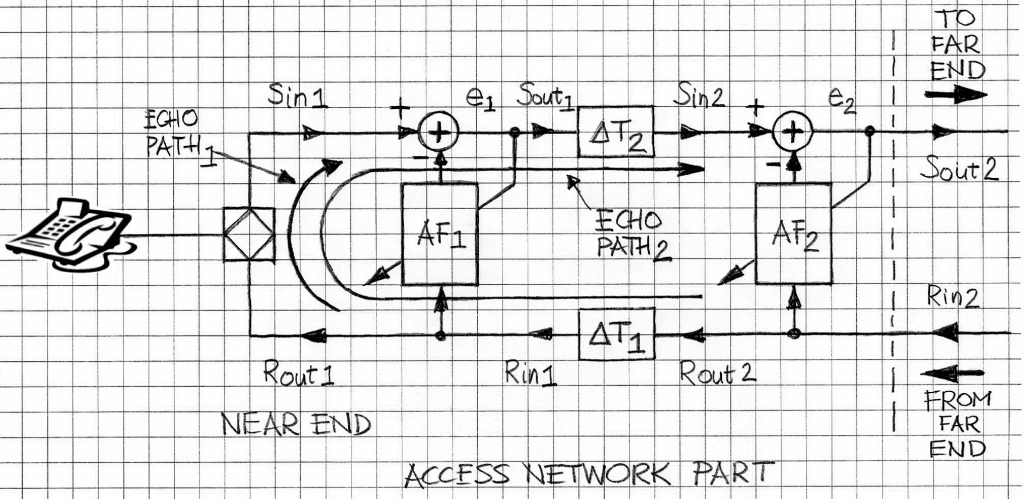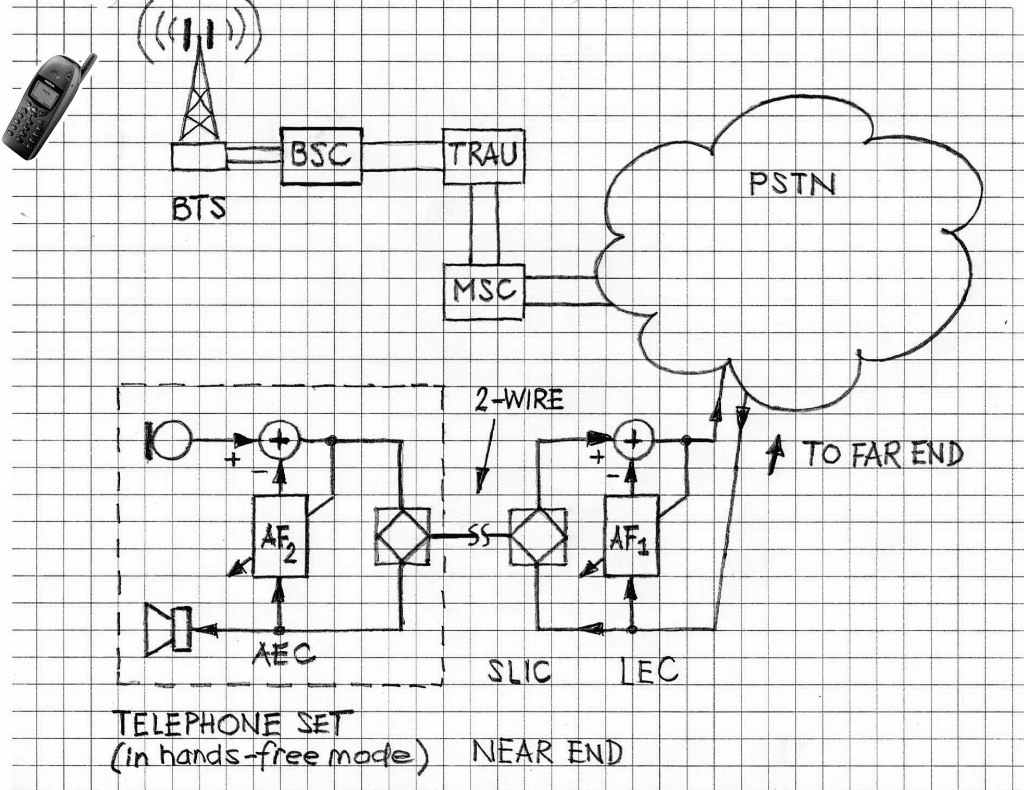The topic of echo cancellers connected in tandem touches many aspects of networking and voice enhancement. ITU-T G.168-2012 (Ref. [1]) defines echo canceller in tandem as “Multiple echo cancellers in a connection that are meant to cancel echo from the same echo source.” (cf. Figure 1). It refers to network echo cancellers, yet by extension, the same definition applies to echo cancellers deployed at boundaries of combined/hybrid networks. Likewise, it applies to a combination of echo canceller working on different principles (such as waveform echo canceller and coded-domain echo cancellers).

The topic of echo cancellers in tandem is not new at all. For example, US Patent 4554417 on tandem echo canceller is dated 1983 (priority date); cf. Ref. [2]. The concept of echo cancellers working in tandem came from real configuration networks connecting end devices. One of the common examples is shown in Figure 2 where there are two echo cancellers (both working as “waveform” echo cancellers, i.e., operating using the input linear PCM signals as opposed to encoded signals), of which LEC (with AF1) cancels the echo produced by SLIC as well as any residual acoustic echo left uncancelled entirely, while AEC (with AF2) is solely dedicated to cancelling the acoustic echo only.

The reality of deployment of miscellaneous echo cancellers in hybrid networks (i.e., networks using different technologies as well networks provisioned ad hoc) prompted researchers to analyze convergence effects coming from the tandem echo cancellers (cf. Refs. [3, 4, 5]). While certainly not all important aspects of tandem echo cancellers have been researched and analyzed to date, the accumulated evidence so far, based on analysis of “waveform” echo cancellers (i.e., “typical” echo cancellers), suggests the following:
- If both echo cancellers’ adaptive filters are of the same type (meaning, driven by the same adaptation algorithm), the convergence of echo cancellers working in tandem is not faster than the convergence of the faster of these two echo cancellers; actually, in most of the simulated cases, the tandem echo cancellers’ convergence is tangibly slower;
- During the initial convergence the residual echo is increased;
- Once both echo cancellers have converged, the residual echo of the tandem echo cancellers differs from the non-tandem echo canceller only very slightly.
These findings suggest that the most of the adverse effects of the tandem configuration manifest during the initial phase of the adaptive filter convergence. While there are no universal remedies to offset these adverse side effects, the most straightforward approach is by disabling the less-performing echo canceller. However often it is not possible, mainly due to limitations of standard communication network protocols, unless it is done during the provisioning phase. In many cases, the second echo canceller is included in the audio channel based on the ongoing dynamic voice connection; thus the option of disabling one of the echo cancellers during the network provisioning stage does not directly apply.
Considerations regarding two tandem echo cancellers of which one is a TFO echo canceller (i.e., operating on the encoded signals/voice data) are included in Refs.[6,7].
VOCAL’s echo cancellers are part of our comprehensive software library for secure, real-time voice, video, fax and data communications solutions over mobile, radio, internet or any other communication network. Contact us to discuss your echo cancellation requirements with our engineering staff.
More Information
References
- ITU-T G.168-2012 Digital Network Echo Cancellers; (02/2012)
- US Patent 4554417, Tandem adaptive echo canceller arrangement.
- Analysis of Two Adaptive Filters in Tandem, Maurice Givens, Senior Member, IEEE; 2000
- A study of two adaptive filters in tandem, Ho, K.C. ; IEEE Transactions on Signal Processing, (Volume:48 , Issue: 6 ) 2000
- Performance of Multiple LMS Adaptive Filters in Tandem, Ho, K.C. ; IEEE TRANSACTIONS ON SIGNAL PROCESSING, VOL. 49, NO. 11, NOVEMBER 2001
- Echo Cancellation in Cellular Networks
- Universal Mobile Telecommunications System (UMTS); User Equipment (UE) radio transmission and reception (FDD) (3GPP TS 25.101 version 6.19.0 Release 6) ETSI TS 125 101 V6.19.0 (2009-03).